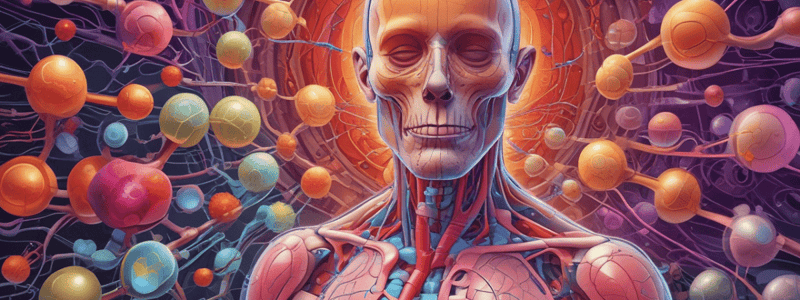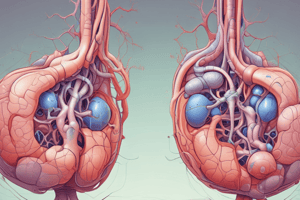Podcast
Questions and Answers
Where are the kidneys located in the body?
Where are the kidneys located in the body?
- Inside the peritoneum
- Behind the peritoneum (correct)
- Outside the peritoneum
- In front of the peritoneum
Why is the right kidney slightly lower than the left kidney?
Why is the right kidney slightly lower than the left kidney?
- To accommodate the stomach
- To accommodate the liver (correct)
- To accommodate the pancreas
- To accommodate the spleen
What is the primary function of nephrons?
What is the primary function of nephrons?
- Producing hormones
- Regulating the concentration of water and other substances in the body (correct)
- Filtering blood
- Maintaining acid-base balance
What is the process by which the kidneys regulate blood pressure?
What is the process by which the kidneys regulate blood pressure?
What is the function of erythropoietin secreted by the kidneys?
What is the function of erythropoietin secreted by the kidneys?
How do the kidneys help maintain a normal blood glucose level?
How do the kidneys help maintain a normal blood glucose level?
How do the kidneys regulate acid-base balance?
How do the kidneys regulate acid-base balance?
Which of the following is NOT a component of the urinary system's function?
Which of the following is NOT a component of the urinary system's function?
Flashcards are hidden until you start studying
Study Notes
Kidney Structure and Function
- Nephrons, tiny structures in renal pyramids, filter gallons of blood daily.
- Kidneys are retroperitoneal organs, located behind the peritoneum.
- The right kidney is slightly lower than the left kidney to accommodate the liver.
Urine Formation
- The 3 main steps of urine formation are: glomerular filtration, reabsorption, and secretion.
- The glomerulus is a network of capillaries surrounded by the glomerular capsule (or Bowman's capsule).
Urine Composition
- Nitrogenous wastes excreted in urine include urea, creatinine, ammonia, and uric acid.
Urination Process
- The internal sphincter is involuntary and surrounds the opening of the bladder to the urethra, relaxing to allow urine to pass.
- The external sphincter is voluntary and surrounds the urethra outside the bladder, requiring relaxation for urination to occur.
Functions of the Urinary System
Regulation of Blood Pressure
- Kidneys regulate blood pressure by controlling extracellular fluid volume and through the renin-angiotensin-aldosterone mechanism.
Hormones Secreted by Kidneys
- Erythropoietin
- Thrombopoietin
- Renin
- 1,25-dihydroxycholecalciferol (calcitriol)
- Prostaglandins
Regulation of Blood Glucose Level
- Kidneys use glutamine in gluconeogenesis, synthesizing new glucose molecules and releasing them into the blood to maintain a normal blood glucose level.
Maintenance of Acid-Base Balance
- Kidneys regulate acid-base balance along with the respiratory system, keeping blood pH at around 7.4 by excreting H+ and reabsorbing bicarbonate (HCO3-).
Studying That Suits You
Use AI to generate personalized quizzes and flashcards to suit your learning preferences.


